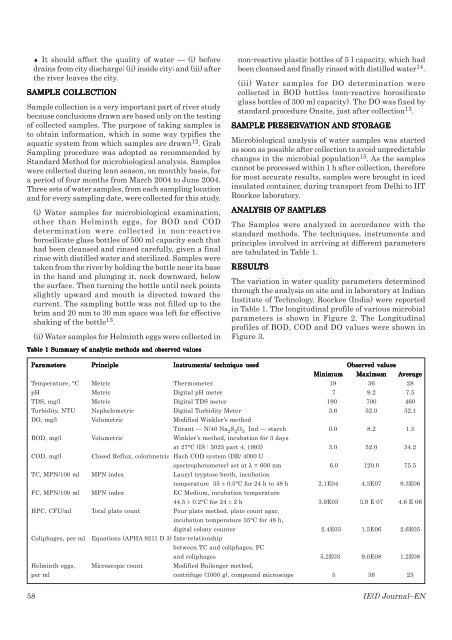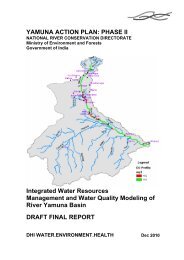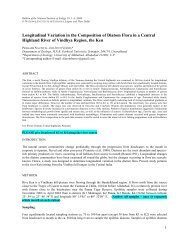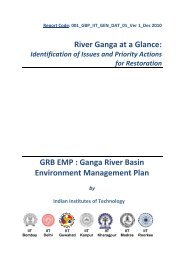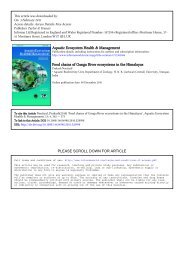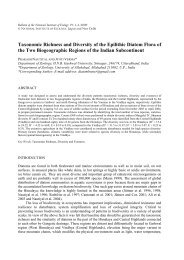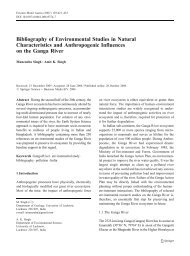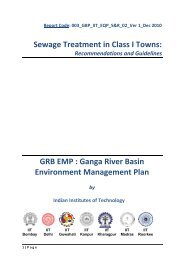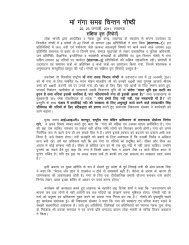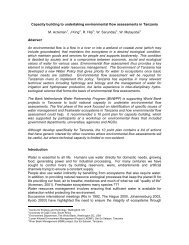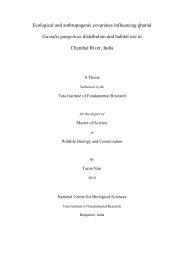Quantitative Study on Microbial Pollution of River ... - GANGAPEDIA
Quantitative Study on Microbial Pollution of River ... - GANGAPEDIA
Quantitative Study on Microbial Pollution of River ... - GANGAPEDIA
You also want an ePaper? Increase the reach of your titles
YUMPU automatically turns print PDFs into web optimized ePapers that Google loves.
♦ It should affect the quality <strong>of</strong> water — (i) before<br />
drains from city discharge; (ii) inside city; and (iii) after<br />
the river leaves the city.<br />
SAMPLE SAMPLE COLLECTION<br />
COLLECTION<br />
Sample collecti<strong>on</strong> is a very important part <strong>of</strong> river study<br />
because c<strong>on</strong>clusi<strong>on</strong>s drawn are based <strong>on</strong>ly <strong>on</strong> the testing<br />
<strong>of</strong> collected samples. The purpose <strong>of</strong> taking samples is<br />
to obtain informati<strong>on</strong>, which in some way typifies the<br />
aquatic system from which samples are drawn 12 . Grab<br />
Sampling procedure was adopted as recommended by<br />
Standard Method for microbiological analysis. Samples<br />
were collected during lean seas<strong>on</strong>, <strong>on</strong> m<strong>on</strong>thly basis, for<br />
a period <strong>of</strong> four m<strong>on</strong>ths from March 2004 to June 2004.<br />
Three sets <strong>of</strong> water samples, from each sampling locati<strong>on</strong><br />
and for every sampling date, were collected for this study.<br />
(i) Water samples for microbiological examinati<strong>on</strong>,<br />
other than Helminth eggs, for BOD and COD<br />
determinati<strong>on</strong> were collected in n<strong>on</strong>-reactive<br />
borosilicate glass bottles <strong>of</strong> 500 ml capacity each that<br />
had been cleansed and rinsed carefully, given a final<br />
rinse with distilled water and sterilized. Samples were<br />
taken from the river by holding the bottle near its base<br />
in the hand and plunging it, neck downward, below<br />
the surface. Then turning the bottle until neck points<br />
slightly upward and mouth is directed toward the<br />
current. The sampling bottle was not filled up to the<br />
brim and 20 mm to 30 mm space was left for effective<br />
shaking <strong>of</strong> the bottle 13 .<br />
(ii) Water samples for Helminth eggs were collected in<br />
Table able 1 1 1 Summary Summary <strong>of</strong> <strong>of</strong> analytic analytic methods methods and and observed observed values<br />
values<br />
n<strong>on</strong>-reactive plastic bottles <strong>of</strong> 5 l capacity, which had<br />
been cleansed and finally rinsed with distilled water 14 .<br />
(iii) Water samples for DO determinati<strong>on</strong> were<br />
collected in BOD bottles (n<strong>on</strong>-reactive borosilicate<br />
glass bottles <strong>of</strong> 300 ml capacity). The DO was fixed by<br />
standard procedure Onsite, just after collecti<strong>on</strong> 13 .<br />
SAMPLE SAMPLE PRESER PRESERVATION<br />
PRESER TION TION AND AND STORAGE<br />
STORAGE<br />
Microbiological analysis <strong>of</strong> water samples was started<br />
as so<strong>on</strong> as possible after collecti<strong>on</strong> to avoid unpredictable<br />
changes in the microbial populati<strong>on</strong> 15 . As the samples<br />
cannot be processed within 1 h after collecti<strong>on</strong>, therefore<br />
for most accurate results, samples were brought in iced<br />
insulated c<strong>on</strong>tainer, during transport from Delhi to IIT<br />
Roorkee laboratory.<br />
ANAL ANALYSIS ANAL YSIS OF OF SAMPLES<br />
SAMPLES<br />
The Samples were analyzed in accordance with the<br />
standard methods. The techniques, instruments and<br />
principles involved in arriving at different parameters<br />
are tabulated in Table 1.<br />
RESUL RESULTS RESUL RESULTS<br />
TS<br />
The variati<strong>on</strong> in water quality parameters determined<br />
through the analysis <strong>on</strong> site and in laboratory at Indian<br />
Institute <strong>of</strong> Technology, Roorkee (India) were reported<br />
in Table 1. The l<strong>on</strong>gitudinal pr<strong>of</strong>ile <strong>of</strong> various microbial<br />
parameters is shown in Figure 2. The L<strong>on</strong>gitudinal<br />
pr<strong>of</strong>iles <strong>of</strong> BOD, COD and DO values were shown in<br />
Figure 3.<br />
Parameters Parameters Principle Principle Principle<br />
Instruments/ Instruments/ technique technique used used<br />
Observed Observed values values<br />
values<br />
Minimum Minimum Maximum Maximum Maximum Average verage<br />
Temperature, °C Metric Thermometer 19 36 28<br />
pH Metric Digital pH meter 7 9.2 7.5<br />
TDS, mg/l Metric Digital TDS meter 190 700 460<br />
Turbidity, NTU Nephelometric Digital Turbidity Meter 3.6 52.0 32.1<br />
DO, mg/l Volumetric Modified Winkler’s method<br />
BOD, mg/l Volumetric Winkler’s method, incubati<strong>on</strong> for 3 days<br />
COD, mg/l Closed Reflux, colorimetric Hach COD system (DR/ 4000 U<br />
TC, MPN/100 ml MPN index Lauryl tryptose broth, incubati<strong>on</strong><br />
FC, MPN/100 ml MPN index EC Medium, incubati<strong>on</strong> temperature<br />
HPC, CFU/ml Total plate count Pour plate method, plate count agar,<br />
Coliphages, per ml Equati<strong>on</strong>s (APHA 9211 D 3) Inte-relati<strong>on</strong>ship<br />
Titrant — N/40 Na 2 S 2 O 3 Ind — starch 0.0 8.2 1.5<br />
at 27°C (IS : 3025 part 4, 1993) 3.0 52.0 34.2<br />
spectrophotometer) set at λ = 600 nm 6.0 120.0 75.5<br />
temperature 35 ± 0.5°C for 24 h to 48 h 2.1E04 4.3E07 9.3E06<br />
44.5 ± 0.2°C for 24 ± 2 h 3.9E03 3.9 E 07 4.6 E 06<br />
incubati<strong>on</strong> temperature 35°C for 48 h,<br />
digital col<strong>on</strong>y counter 2.4E03 1.5E06 2.6E05<br />
between TC and coliphages, FC<br />
Helminth eggs, Microscopic count Modified Bailenger method,<br />
and coliphages 5.2E03 9.0E08 1.2E08<br />
per ml centrifuge (1000 g), compound microscope 5 38 23<br />
58 IE(I) Journal–EN


